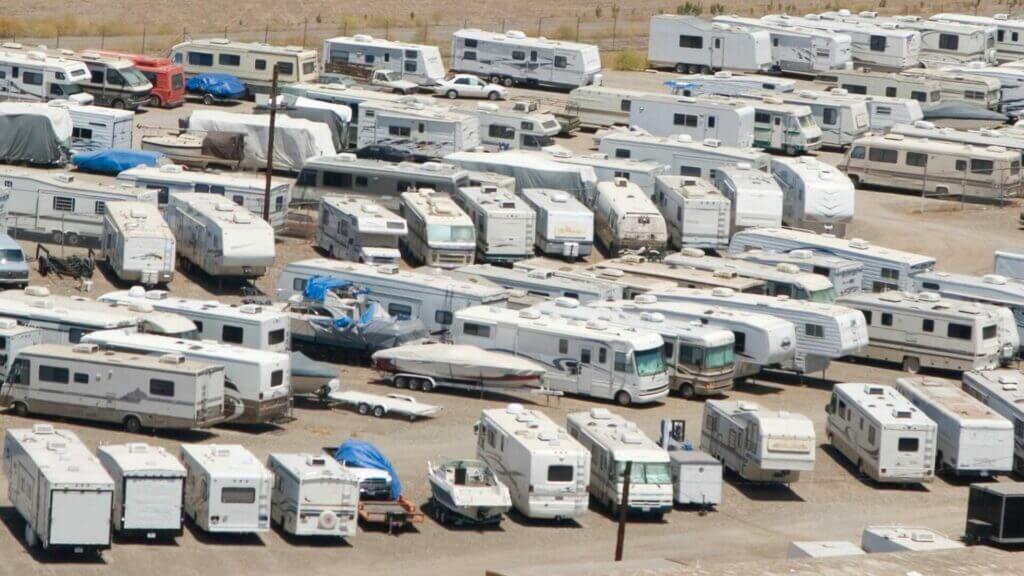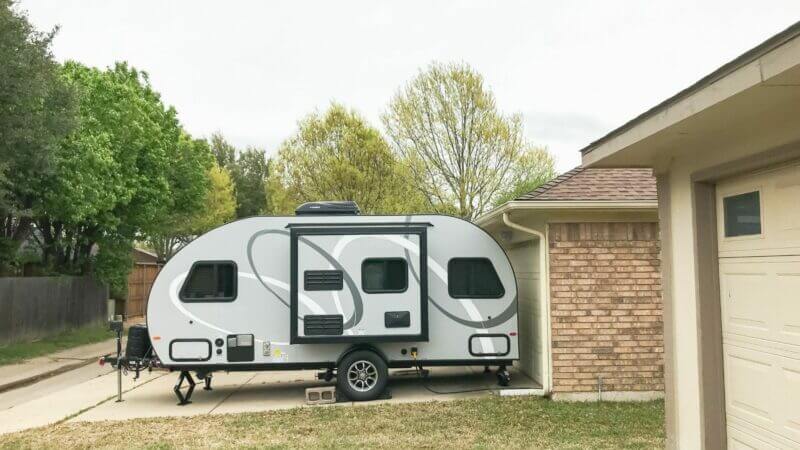Table of Contents Show
If camping season is over or you’re taking your rig out less frequently, you might find yourself asking an important question–how much does it cost to store an RV? There are a few key elements you should consider when answering that question. Let’s take a look.
Storing Your RV
Storing your RV might not seem like the most obvious thing to do. After all, aren’t these things designed to be outside? However, there are plenty of reasons you might need or want better storage than what’s available at your home.
Parking is a significant consideration. You might not have a driveway or not have one big enough for a large RV or trailer. You might have local laws or HOA restrictions prohibiting street parking or parking on your property.
You may also be looking to protect your RV. These massive, expensive vehicles can potentially present a significant opportunity for criminals seeking valuables or other items. In areas with lots of rain, snow, or wind, extended exposure to the elements can also damage your RV.
Even if none of those issues are concerning, it might still make sense to store your RV by choice. Perhaps you routinely take your RV out to the same area multiple times a year. It might make sense to keep your RV closer to your destination to avoid the cost and hassle of driving it the whole way every time.
RV Storage Options
There are several different types of storage that dictate how much it costs to store an RV. Here’s what we suggest.

Outdoor RV Storage
Outdoor RV storage is essentially just a parking spot and likely some security. Depending on the facility, you’ll generally park on gravel, concrete, or asphalt. Your RV will remain exposed to the elements, so consider the impact this may have if you live in an area with lots of sun, wind, rain, or snow, and invest in an RV cover or tarp.
Covered RV Storage
Covered RV storage provides some additional protection for your RV. These are often carport-style stalls or awnings designed to keep the rain, snow, and sun off your rig while it’s stored. Even though your RV is covered, it will still face outdoor temperatures, which can potentially trouble your RV systems in extremely hot or cold climates.
Indoor RV Storage
Indoor storage offers the most protection for your precious RV, and it’s available in both shared and private varieties.
Shared indoor RV storage grants you a reserved spot in an indoor garage. Private storage is often a garage or storage locker-type space.
For either type, climate-control is frequently available. This offers maximum protection for your RV, letting it rest in a shaded, dry, temperature-controlled, and secure space.
Factors that Affect the Price of RV Storage
When it comes to finding ideal RV storage, remember that you get what you pay for. In this case, your money will buy you different things based on your needs. Here are a few things to keep in mind.
Size of Space Rented
Prices can vary greatly depending on how much space you need. A small spot for a class B will naturally cost less than a mega-site for a vast class A, with a class C costing somewhere in between. It’s essential to know your RV’s dimensions since units or spaces are usually described by length and width.
Indoor, Outdoor, or Covered
As mentioned above, the various protection levels provided with RV storage will lead to different costs overall. The dollar amount these protections will add depends on the RV storage room climate.
Location
RV storage facilities in populated areas or close to certain attractions will command higher prices than those in more remote or less desirable areas. The reason is simple–you’re competing against fellow RV owners for the same popular spot.
Facility Amenities
The amenities can make a storage facility stand apart. They may be general amenities like security and on-site support, or they could be more RV-specific perks like electricity and water hookups. Some even have dump stations on-site to save you a stop on your way back from camping.
How Much Does It Cost to Store an RV?
Factor in the above items to develop your overall storage costs. Overall, the self-storage marketplace Sparefoot reports roughly $131/month on average for RV storage.
For outdoor storage, costs can start at $30/month for spots with limited amenities, up to as much as $100/month in places with high demand or lots of features and amenities.
For non-climate-controlled indoor storage, expect to pay $50 to $125/month. Heated RV storage generally starts around $100/month and can go as high as $450/month. As you can see, each storage type’s additional features come with a higher cost, so consider your needs and budget when making a choice.
Tips for Storing Your RV
When something sits unused for an extended period, there are certain risks attached. To avoid that happening with your RV, take care of a few items before storing them!
Remove All Personal Belongings
Remove anything you can, especially anything of value. The less you’re storing in the RV, the better. Since various types of storage can have different levels of climate control and security, it’s better to be safe than sorry. No one wants to come back and find a pricy gadget or treasured item stolen or damaged.
Drain Lines and Winterize if Necessary
If your RV will be exposed to cold temperatures while in storage, it’s vital to winterize your water system. After disconnecting your rig from city water, turn on each faucet and fixture (including showers and toilets). Keep the lines open until water has stopped flowing.
You’ll now need to add RV antifreeze to the lines. Instructions vary between different RVs but avoid passing the antifreeze through your freshwater tank. We also recommend bypassing your water heater if possible so you can save on antifreeze.
Use Moisture Absorbers to Prevent Mold
Moisture is the enemy in enclosed, poorly ventilated spaces like stored RVs. It’s critical to use moisture absorbers within your rig to lessen the possibility of mold or other damage. Familiar brands like Damp Rid or Dri-Z-Air work well for this purpose.
- DampRid Hanging Bag Moisture Absorber attracts and traps excess moisture from the air. Nontoxic and septic safe
- By trapping excess moisture, these bags eliminate musty odors creating fresher, cleaner air
Prop Open Refrigerator
Along the same lines, take extra steps to prevent mold or moisture damage in your refrigerator while in storage. Prop the fridge door open if possible to allow airflow while not in use. You can also spring for a door holder to keep the door open.
- Refrigerator Door Vent Prop;
- Use To Hold Refrigerator/ Freezer Door Open To Allow Light And Ventilation;
To sum up, how much does it cost to store an RV? As you can see, the answers range from bargain to premium prices. Consider your situation, climate, rig, and budget. You have no shortage of options!
Last update on 2024-12-28 / Affiliate links / Images from Amazon Product Advertising API








